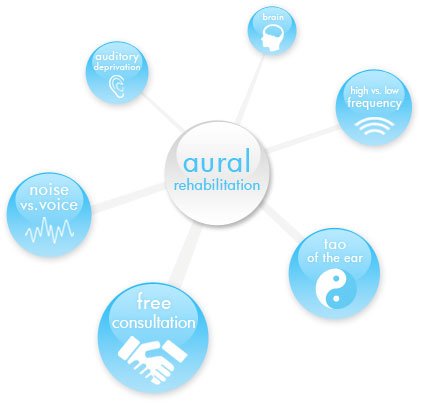What is aural rehabilitation?
Aural rehabilitation describes the process of identifying and treating hearing loss based on each patient’s unique goals. After a diagnostic hearing test is completed and the commitment to treating hearing loss is made, an aural rehabilitation plan is developed to help target specific listening and communication needs. Often, the aural rehabilitation plan is created with the patient’s age, severity of hearing loss, and subjective listening difficulties in mind. Aural rehabilitation is also intended to educate the patient and their loved ones about the auditory system, hearing loss, realistic expectations from amplification, communication strategies, etc. The treatment plan may include individual sessions with the audiologist or group rehabilitation for patients with similar needs.
When a hearing treatment plan is designed, the audiologist may decide to have you complete your aural rehabilitation at home or exclusively face-to-face in the office. Typically, a combination of approaches is used to reach established goals. For example, your audiologist may create auditory training exercises and practice them with you during an appointment, then assign you homework to practice those exercises at home. To supplement exercises provided by the audiologist, use of electronic forms of auditory training may be encouraged. No matter the exercise, it is recommended that family members or significant others participate in your aural rehabilitation. Friends and family not only give you the encouragement you need to reach your goals, they also help you practice listening to the voices that matter the most.
How can it help me?
By identifying a patient’s hearing loss, determining areas of listening difficulty, and establishing specific goals, aural rehabilitation can greatly improve your satisfaction with hearing devices. After obtaining hearing devices, the patient has to learn to listen to things they haven’t heard in a while and create new listening habits. The auditory centers of the brain need exercise to adequately process sound, get used to amplification, and complete more difficult listening tasks such as understanding speech in background noise. Retraining the brain takes time and effort. Unfortunately hearing devices alone cannot always help a patient reach their listening goals so a detailed aural rehabilitation plan is created.
How do I start an aural rehabilitation plan?
The first step of creating an aural rehabilitation plan is to obtain a comprehensive hearing test and assess the degree and type of hearing loss. If appropriate, a hearing aid evaluation appointment will be scheduled to discuss recommendations for amplification in detail with a doctor of audiology. At the hearing aid evaluation, your audiologist will assess what areas you have the most difficulty hearing and what situations you hope to improve with hearing devices. Questionnaires may also be completed at the hearing aid evaluation to help the audiologist determine your listening needs. Your audiologist will then make a recommendation for a hearing device and accessories based on your hearing loss, unique listening needs, and other concerns, such as dexterity.
Once fit with appropriate technology, you will create goals with your audiologist, such as “improve ability to hear my wife when we go out to our favorite restaurant” or, “improve my ability to hear my grandchildren on the phone”. Your goals will be recorded and a plan will be created to improve those specific areas.

Summary
- An effective aural rehabilitation plan includes appropriate hearing devices provided by a licensed doctor of audiology.
- Auditory training exercises are also essential to an aural rehabilitation plan, which are assigned by the audiologist to train the brain. Auditory training exercises can be in the form of phone apps, listening games, books on tape, learning a musical instrument, etc. and are assigned based on your hearing goals.
- If you are still struggling to hear in certain situations, accessories or assistive listening devices may be considered to help decrease communication breakdowns.
- The performance of your hearing devices should be verified after reaching your full prescription to ensure you are getting your full benefit from amplification.
- Questionnaires may also be completed a multiple appointments to track success of aural rehabilitation.
It is important to remember that the auditory centers of the brain require training to meet your treatment goals. You will need to develop an aural rehabilitation plan with your audiologist and commit to the process to get the maximum benefit from your hearing devices.
